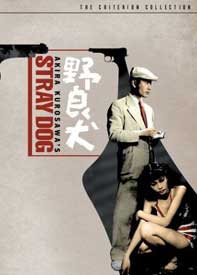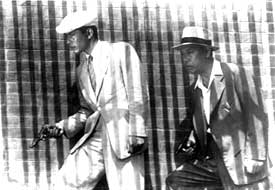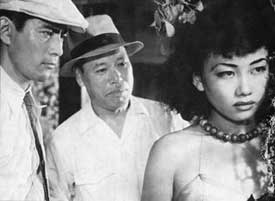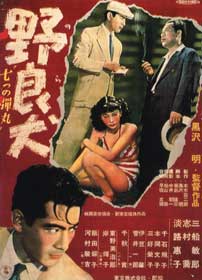 A young Tokyo police detective Murakami (Toshiro Mifune) has lost his gun on the crowded train, to a pickpocket, in the opening scenes of Stray Dog (Nora inu, 1949).
A young Tokyo police detective Murakami (Toshiro Mifune) has lost his gun on the crowded train, to a pickpocket, in the opening scenes of Stray Dog (Nora inu, 1949).
He's devastated by his own ineptitude, ready & willing to resign his position. While his bosses decide whether or not to sack him, he's given quiet support throughout the force to try to get the gun back before it is used in some crime.
He begins trailing Ogin (Teruko Kishi), a notorious train pickpocket, famous before the war for her beauty & her perfect kimonos. Now she's worn down, in modern dresses, still plying her trade.
She's no the culprit, but Murakami figures she knows something. She can't ply her trade when every time she looks up the detective is nearby.
Eventually she snaps & gives him his first clue, about where a gun like his would find its way to the "gun rental" underground.
 It's a relentlessly hot summer week. Indeed, the very first scene we see when the film starts is an unwholesome looking dog panting wildly, & the symbol of the Stray Dog soon becomes humanized.
It's a relentlessly hot summer week. Indeed, the very first scene we see when the film starts is an unwholesome looking dog panting wildly, & the symbol of the Stray Dog soon becomes humanized.
Characters are sweating furiously, wiping their necks with rags, fanning, trying to cool off.
Our hero wanders the crime-ridden post-war neighborhoods of destitution & desparation & degradation populated by unemployed laborers, tramps, prostitutes, thieves & yakuza, but also a world of lost souls who cling however timidly to old dreams.
The view of poverty & criminality at this time in Japanese history is all too convincing, even if curiously attractive due to the stunning combination of film noir & cinema verite photography of the highest order of art. Having been filmed during the Occupation, many of these street scenes are true location shots, historical revelations in themselves.
 When his gun is used in a crime, he joins senior officer Sato Abe (the great character actor Takeshi Shimura) on the new case. Murakami's warm mentoring by Sato is recurring theme in Kurosawa films, as in Red Beard (Akehage, 1965) wherein Mifune is the mentor. It's fascinating to see him as a young actor in the rookie position.
When his gun is used in a crime, he joins senior officer Sato Abe (the great character actor Takeshi Shimura) on the new case. Murakami's warm mentoring by Sato is recurring theme in Kurosawa films, as in Red Beard (Akehage, 1965) wherein Mifune is the mentor. It's fascinating to see him as a young actor in the rookie position.
The young man Yusa (Isao Kimura) who has the gun has survived war terrors & now lives in a shack behind his sister's place. He's depressed -- today we might recognize his condition as post traumatic stress -- & losing what little is left of his equilibrium.
He has already shot & injured two people, & bound to do worse. He's lashing out irrationally, a dangerous man, though one we can feel sad for rather than despise.
Murakami is getting pretty gloomy, too, at the hopelessness of tracking down a single weapon, overwhelmed by his own responsibility.
The tale works for its police procedural content, for its dispirting film noir attitude, & as a series of brilliant character stories at a painful moment in Japanese history. The tale builds in suspense until it reaches an action-crescendo with Detective Abe wounded & Murakami unwilling to stop his final pursuit of Yusa even if it gets him shot point-blank by the pitiful madman.
A great film, deserving to be placed on lists of the world's best film noirs. Not to mention, great hats.
copyright © by Paghat the Ratgirl
|

